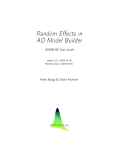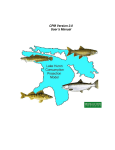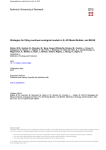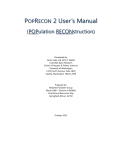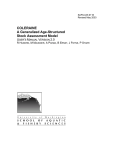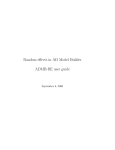Download Notes on AD Model Builder by a novice
Transcript
Notes on AD Model Builder by a novice
Ben Bolker
November 10, 2010
Mostly created 11 August 2009, not significantly updated since then. Some
issues may have been resolved.
This document describes my discoveries and frustrations as I started to learn
how to use AD Model Builder (and ADMB-RE). Note to ADMB developers:
please take this all as constructive criticism! ADMB is a great tool and I hope
these comments will contribute to its development and ease of uses for others
...
1. I got quite confused by the distinction between tpl2cpp and tpl2rem:
I now know that these are used for constructing models without and
with random effects, respectively, but this wasn’t clear initially when I
was poking around in the bin directory trying to figure out what to do.
There seem to be a confusing number of different possible scripts and
wrappers: the ADMB-RE manual refers to an admb script, which didn’t
come with the binary version of ADMB that I downloaded (despite the
fact that the binary did allow the construction of ADMB-RE models).
I eventually downloaded from http://admb-project.org/community/
editing-tools/admb-ide/scripts-linux.zip/view?searchterm=Scripts
and got the admb script. Appendix C of the ADMB-RE documentation
is really useful . . . it might also be useful to mention adlink and adcomp,
which are used in the admb script . . . a Makefile would be nice (so one could
rebuild only the necessary pieces), but it might be overkill and might be
too hard to make it properly cross-platform (since Windows users etc.
would have to get a make executable from somewhere).
Probably most of this confusion would have been avoided if the binary
distribution I downloaded had actually had an admb script, and if that
was consistently referred to throughout both the ADMB and the ADMBRE manual. ADMB manual only mentions tpl2cpp (of course, since it
preceded ADMB-RE), ADMB-RE mentions both but never explicitly says
exactly what they are.
2. At one point I thought that file names with dashes were somehow broken,
but now I think I must just have been confused — can’t replicate.
3. ADMB is case sensitive in a slightly nasty way, which must come from its
Windows/DOS heritage but is a little odd on a *nix system. In particular,
1
it converts file names to lower case — if the TPL file is called Simple.tpl,
it will look for a DAT file called simple.dat (and fail to find one called
Simple.dat . . .
4. If parameters are specified, the order in the PIN file must match the order
in which they are defined in the TPL file . . . this is perhaps obvious, but
screwed me up a few times (I have gotten lazy and used to the expectation
that things are named and matched up according to their names). Seems
one could write an automatic checker for this reasonably easily?
5. ADMB “does the right thing” with scalar*vector arithmetic (and vector*matrix and ?? vector+vector), but one must remember to use elem prod
for elementwise vector multiplication . . . (this is mostly a problem for R/SPLUS users, since C/C++ has no such expectation and MATLAB uses .*
for elementwise operations . . .
6. No errors thrown on vector size mismatch????? (there is something in
http://courses.washington.edu/fish507/ADMB%20living%20doc.doc
that describes how to turn on bounds-checking, but it looks like this only
works in an IDE?? . . . )
7. is there an equivalent of parallel min/max (pmin/pmax in R)? It would be
useful for bounds checking, although the built-in posfun does work.
8. various experimentation with bounds, etc. — bounding parameters at
zero where sensible seems to help even when it doesn’t appear that there
is such a problem at the end point
9. tpl2rem (needed for random effects models) appears to be fussy about dos
vs unix mode (not sure about this any more, don’t know if I can replicate
it)
10. One can (apparently) ignore errors of the form cat: xxalloc4.tmp: No
such file or directory cat: xxalloc5.tmp: No such file or directory
Error executing command cat xxglobal.tmp xxhtop.tmp header.tmp
xxalloc1.tmp xxalloc2.tmp xxalloc3.tmp xxalloc4.tmp xxalloc5.tmp
xxtopm.tmp xxalloc6.tmp > mccoypred3.cpp. I think (??) these are
produced by ADMB-RE models that are “too simple” (??)
11. some warnings when compiling code . . . many fewer as of a recent update
— would be nice if legal code compiled cleanly, without warnings. My
ADMB models now compile cleanly, but my ADMB-RE code gives
In file included from ./df1b2fun.h:126,
from mccoypred5.cpp:2:
./df32fun.h:98: warning: extra qualification df3_two_vector:: on member allocate
./df32fun.h:150: warning: extra qualification df3_two_matrix:: on member df3_two_matrix
In file included from mccoypred5.cpp:2:
./df1b2fun.h:715: warning: extra qualification df1b2_gradlist:: on member write_pass1
2
In file included from ./df1b2fun.h:1555,
from mccoypred5.cpp:2:
./df3fun.h:87: warning: extra qualification df3_one_vector:: on member allocate
./df3fun.h:139: warning: extra qualification df3_one_matrix:: on member df3_one_matrix
12. I had trouble deciding whether random effect values needed to be included
as a starting value or not: since they are specified as random_effects_vector
rather than init_vector it wasn’t clear to me. Dave Fournier points out
that they are not required ; my best guess is that the default behavior is to
make all starting values equal to zero if a PIN file is not specified (and if
the values are not specified as bounded in the PARAMETER SECTION and if
no explicit assignments are made in the INITIALIZATION SECTION), but
it’s a little hard to tell. He says “the easiest way to make a pin file is to run
the model with the command line option -maxfn 0 [sets maximum number of function evaluations to zero] and copy the output par file (*.p01)
in this case to *.pin and edit it.” (P. 1-28 of the ADMB manual says “If
the model finds the parameter file (whose default name is admodel.par)
. . . ” Should that be admodel.pin??)
13. Likelihood profiles: are likelihood profiles (-lprof/likeprof number) supposed to work for ADMB-RE models? Is likeprof number supposed to be
used in addition to the standard init definition, or in its place? Where
is the likelihood profile information stored?
If I add a likeprof number declaration to my non-RE code, I get:
In file included from mccoypred2.cpp:6:
./mccoypred2.htp:52: error: declaration of param_likeprof_number model_parameters::g
./mccoypred2.htp:49: error: conflicts with previous declaration
param_init_number model_parameters::g
With RE code I get:
In file included from mccoypred5.cpp:24:
./mccoypred5.htp:72: error: declaration of param_likeprof_number model_parameters::g
./mccoypred5.htp:59: error: conflicts with previous declaration
param_init_bounded_number model_parameters::g
./mccoypred5.htp:126: error: declaration of df1b2variable df1b2_parameters::g
./mccoypred5.htp:113: error: conflicts with previous declaration
df1b2_init_bounded_number df1b2_parameters::g
mccoypred5.cpp: In constructor model_parameters::model_parameters(int, int, char**):
mccoypred5.cpp:68: error: no matching function for call to
param_init_bounded_number::allocate(const char [2])
/usr/local/src/admb/include/admodel.h:1012: note: candidates are:
void param_init_bounded_number::allocate(double, double, int, const char*)
/usr/local/src/admb/include/admodel.h:1013: note:
void param_init_bounded_number::allocate(double, double, const char*)
3
mccoypred5.cpp: In member function virtual void df1b2_parameters::allocate():
mccoypred5.cpp:238: error: no matching function for call to
df1b2_init_bounded_number::allocate(const char [2])
./df1b2fun.h:1315: note: candidates are:
void df1b2_init_bounded_number::allocate(double, double, int, const char*)
./df1b2fun.h:1318: note:
void df1b2_init_bounded_number::allocate(double, double, const char*)
If I don’t add likeprof number declarations, running the code with the
-lprof switch doesn’t do anything bad, but doesn’t seem to produce
profiles either (at least, I can’t find it)
14. check likelihood on scaled N (0, 1) variables? (p. 18 of ADMB-RE manual); try this both ways . . .
15. (non-significant) typos in manuals — where should I report these?
16. note: negative binomial log-likelihood log negbinomial density is parameterized with (variance/mean), which is (1 + µ/k) or (1 + θµ) in the
more usual (overdispersion parameter) parameterizations
Thoughts/wishes:
1. it will be nice to have a full SVN setup, comparable to more typical
*nix/open-source situations, where checking out the source directories and
running “./configure; ./make” in the root directory Just Works. At the
moment, I can get all of the source files, but it’s fairly difficult to figure
out the appropriate flags etc. etc. for building and linking the appropriate
library files.
2. any chance of a “1-click” (or small-number-of-clicks) installer for Windows? Does the IDE version put everything in the right places so that
ADMB “just works”?
3. Can I get admb-mode from the google code pages without getting the full
66MB zip file and digging through it?
4. how about .deb/.rpm packages for Linux . . . ? Debian repositories so I can
just say apt-get install admb?
5. it would be nice to have df1b2vector pow(const df1b2vector& v,const
df1b2variable & x) defined in ADMB-RE, so I could leave it out of my
TPL file . . .
6. it seems a little odd that sdreport must be explicitly turned on to get
MCMC results for a parameter, when otherwise all parameters are reported on — is this just to save space when the parameter vector is long?
4
7. R integration: there are various attempts, but I think (IM perhaps NSHO)
that they could be improved and made more “R-ish”. I get the sense that
there is not a huge amount of overlap (alas) between people who know
ADMB and R idioms well . . . The primary integration attempts are
• some code in glmmADMB (which I have made use of in my stuff, especially dat_write and pin_write). See below for nit-picks . . .
• ADMB2R, which
• PBSadmb (http://code.google.com/p/pbs-software/); this might
be great, but it’s GUI and not cross-platform, both of which put me
off a little bit . . . I am used to developing in R and would like to work
that way. Glancing over the PBSadmb user’s manual, I’m a little bit
surprised that the authors haven’t used (at least) S3 classes to define
a class of admb (or admb_fit) objects and associated methods (plot,
print, summary etc.); maybe this is because of the GUI approach?
In any case, I wouldn’t want to reinvent the wheel too thoroughly
...
8. would be nice to have negative log-likelihood helper functions defined for
some other standard distributions (Poisson, Cauchy, neg. binomial are
defined, but not binomial, beta-binomial, Beta . . . )
9. It might be useful to write some vignettes showing how one could use
model.matrix() and perhaps some digging in the guts of lmer models to
easily construct model matrices for the random and fixed effects? Again,
wouldn’t want to re-invent too much of glmmADMB . . .
10. glmmADMB is nice, but frustrated me a bit:
(a) documentation holes and general missing pieces (e.g., some of the
documentation still has stubs in it (see help("glmmADMB-package"));
offsets are implemented but not documented (at least in version 0.3);
I get a warning about cannot remove file ’nbmm.std’ when I run
example(glmm.admb))
(b) I find the banner “Welcome to glmmADMB” irritating — I prefer
packages that don’t announce themselves;
(c) the license is undefined . . .
(d) general binomial (with N > 1) variables aren’t possible (although the
package description only says “Poisson or negative binomial response
distributions”, so even Bernoulli is better than documented)
(e) it prints all the intermediate sampling results (I would rather have
it be silent, or at worst produce some kind of estimated-progress bar
. . . although that could be a little tricky for a standard progress bar
since we don’t really know how long it’s going to take — but we could
just print “progress dots” every few steps)
5
(f) the one time I tried to use importance sampling it failed (granted I
didn’t try too hard). (I will mention that Dave Fournier immediately
sent back ADMB code that would do what I wanted — but, since I
wasn’t ready to plunge into “full” ADMB at the time, I didn’t try it
out.)
There are plenty of other nice extensions (e.g. allow MCMC, retrieval of
MCMC results) that would be straightforward.
What are all the files that admb spits out?
• admodel.dep:
• admodel.hes (binary):
• hesscheck
• hessian.bin
• *.eva
• *.log
• *.luu
• *.rhes
• *.bar
• *.par: parameter input
• *.p01: parameter output
• *.b01: (binary) parameter output
6







